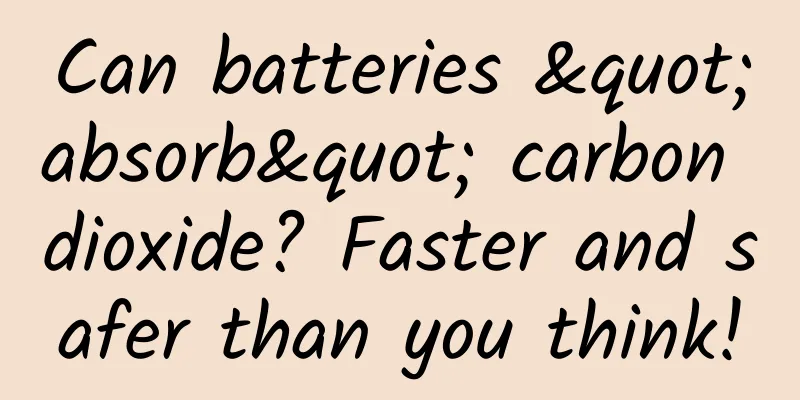Can batteries "absorb" carbon dioxide? Faster and safer than you think!

|
Produced by: Science Popularization China Author: Salty Fish in the Sea (Master of Optics from Changchun Institute of Optics and Fine Mechanics, Chinese Academy of Sciences) Producer: China Science Expo In this ever-changing world, we are faced with an unavoidable problem: energy. Energy is the basis for the development of our society and the cornerstone of modern life. As early as in ancient times, humans learned to preserve and use fire in their work, which triggered the first energy revolution and gave humans the ability to control natural resources. Charcoal barbecue is a typical scene in this stage. In the 1770s, the world's first steam engine powered by coal appeared. The Second Industrial Revolution brought mankind into the steam age, and coal-fired steam trains greatly increased human transportation capabilities. With the development of electromagnetism, people have successively made practical generators and electric motors. Electricity, which is easy to transmit and use, has replaced internal combustion engines, marking the arrival of the third energy revolution. Now we can use electric ovens to grill meat, and there are electric-driven high-speed trains for taking trains. (Photo source: VEER Gallery) However, traditional fossil fuel energy is not unlimited, and the pollution and greenhouse gas emissions generated during its use have an impact on our environment. This makes the development of new energy sources particularly important and urgent. New energy, reducing dependence on fossil energy Global climate change has become one of the biggest challenges to human development, and has greatly promoted the global political consensus and major actions to address climate change. Global climate change poses a major threat to the global human society. The Intergovernmental Panel on Climate Change (IPCC) report in October 2018 stated that in order to avoid extreme damage, the world must limit global warming to 1.5°C. This goal can only be achieved if the world achieves net zero greenhouse gas emissions by the middle of the 21st century. In order to achieve the goal of zero greenhouse gas emissions, finding and developing environmentally friendly alternative energy sources is a top priority for development. Among them, photovoltaic power generation and wind power generation, which we are very familiar with, are good alternative energy sources. At present, my country's centralized photovoltaic power generation and wind power generation are ranked first in the world, but both power generation methods are unstable and cannot be directly connected to the power grid. The power grid is divided into the power generation end and the power consumption end. The power generation end has to adjust the power generation in real time according to the power consumption end's demand for electricity. Thermal power plants can control the power generation by adjusting the amount of fuel burned, while the power generation of photovoltaic power generation and wind power generation is determined by natural conditions. At night, the demand for electricity for lighting increases, but photovoltaic power generation cannot be used. For wind power generation, the natural wind speed will also cause the power generation to fluctuate, which leads to a waste of electricity. The emergence of energy storage technology is an excellent driving force for the efficient use of renewable energy. (Image source: self-made by the author) If electricity is compared to water, the power generation end is equivalent to a tap that discharges water, and the power consumption end is a water pipe. The water output of the new energy tap may not always meet the flow demand of the water pipe. At this time, energy storage technology plays the role of a reservoir. By storing a certain amount of electricity through energy storage technology, the excess power generated by the power generation end can be stored to meet the needs of the power consumption end when power generation is insufficient. Compared with pumped-storage power stations, compressed air energy storage stations, and water electrolysis hydrogen energy storage, electrochemical energy storage technology is not restricted by geology, topography, and environment. It can directly store and release electricity and has great industry prospects. Currently, lithium batteries dominate the electrochemical energy storage industry. However, since the problem of lithium dendrite growth during the use of lithium-ion batteries has not been solved (during the use of lithium-ion batteries, dendritic metal formed by the accumulation of metallic lithium will be generated at the negative electrode, which will reduce battery performance and may cause battery short circuit, combustion or explosion in severe cases), large-scale applications have high safety risks. Killing two birds with one stone: energy storage batteries that absorb carbon dioxide In order to solve the various defects of existing batteries, researchers have racked their brains to strive to obtain an "excellent" battery that is both efficient and environmentally friendly and safe. Next, we would like to introduce an extremely environmentally friendly energy storage battery that absorbs carbon dioxide during energy storage and helps achieve carbon neutrality - the aqueous organic flow battery. (Image source: Reference 1) The model of an aqueous organic flow battery is shown in the figure above, including components such as storage tanks, electrolytes, circulation pipes, circulation pumps, electrode plates, current collectors, and diaphragms. This type of battery stores or releases energy through chemical reactions of organic matter dissolved in water. The positive and negative electrolytes are organic molecules with reversible electrochemical redox ability (i.e., electroactive organic molecules), and are stored in two tanks respectively. Driven by the circulation pump, the electrolyte is transported to the electrode surface through the circulation pipeline to undergo electrochemical redox reaction, thus realizing energy storage or release. The electrode plate, current collector and separator constitute the main part of the battery. The electrode plate is usually made of high-density graphite plate with flow grooves, which serves as both an electron path and a fluid path. The current collector is the place where the electroactive organic molecules undergo redox reactions, and often uses conductive materials with high specific surface area, such as carbon felt, graphite felt, flexible carbon cloth or carbon paper. The separator plays the role of separating the positive and negative electrodes. In order to effectively inhibit the crossover of electroactive organic molecules while allowing charged ions such as H+, Na+, K+, Cl- to pass through to balance the charge, cation exchange membranes are generally used to adapt to negatively charged organics and anion exchange membranes are used to adapt to positively charged organics. Wang Pan's team at Westlake University, in collaboration with research teams from Harvard University and University of the Chinese Academy of Sciences, developed a class of water-soluble organic energy storage small molecules based on phenazine derivatives, and proposed a method to achieve integrated electrochemical carbon capture during the charging and discharging process of aqueous organic liquid flow batteries. (Image source: Reference 2) During the charging process of this type of battery, each energy storage molecule in the electrolyte stores electricity while the originally neutral electrolyte environment is converted into an alkaline environment that is easy to dissolve carbon dioxide. This environment can efficiently dissolve carbon dioxide in the air. (Image source: Reference 2) During the discharge process, the energy storage molecules release electricity while turning the alkaline environment into an acidic environment. Carbon dioxide has low solubility in an acidic environment, so it escapes from the electrolyte and turns into gas again, which is then collected. The charging and discharging of the battery causes the acidity and alkalinity of the electrolyte to "swing", and scientists use this property to capture and collect carbon dioxide in the air. The research team found in experiments that after 200 cycles, the efficiency of the battery is still very high. After simulation calculations, it was found that the efficiency of this battery is not inferior to that of a number of new batteries. This result was published in the journal Nature Energy. Conclusion In ancient times, humans relied on biomass energy fixed in plants in firewood to heat things for heating, then used oil and coal with higher energy density, and now can directly convert solar energy, wind energy and even atomic energy into easily transmitted electricity for use in thousands of households. Our demand for energy is increasing, but the impact on the environment is also becoming more and more important. The development of efficient, environmentally friendly and safe energy collection and storage devices is a technical challenge that must be overcome for sustainable development of mankind. References: [1] Kong Taoyi, Dong Xiaoli, Wang Yonggang. Research progress of active materials for aqueous organic flow batteries[J]. Scientia Sinica: Chemistry, 2023, 53(08): 1419-1436. [2]WangP,PangS,JinS,etal.High-CapacityandHigh-StabilityElectrochemicalCO2CaptureCellwithCoupledElectricityStorage[J].2023. [3] Gong Yiping, Wang Chenhui, Xiu Xiaoqing, et al. A review of research on large-scale energy storage technology and multifunctional applications [J]. Power Supply and Use. 1006-6357.2023.02.010. [4] Huang Jianhang, Wang Yonggang, Xia Yongyao. Research progress of new energy storage chemical power sources[J]. Power Sources Technology, 2020, 44(06): 793-798. [5] Peng Kang, Liu Junmin, Tang Gonggen, et al. Research status and prospects of electrochemically active molecules in aqueous organic flow batteries[J]. Energy Storage Science and Technology, 2095-4239.2022.0009. [6] Lu Liming. Analysis of the current status and development trend of new energy power generation technology[J]. Engineering Construction and Design, 2020.11.250. [7] Li Yuanyuan. Design and performance research of key materials for aqueous organic flow batteries[D]. University of Science and Technology of China. 2022.001681. |
<<: Salted duck eggs are “rich in oil”, but has the fat content increased?
Recommend
How to review an event you have organized? From what perspectives should information and data be collected?
Xiao Wang organized an activity, hoping to increa...
Ideal Auto: In February 2024, Ideal Auto delivered 20,251 vehicles, a year-on-year increase of 21.8%
Ideal Auto announced its sales results for Februa...
The ticket to marketing master: user thinking
What is user thinking? User thinking is to think ...
[Live] DCloud CTO Cui Hongbao: How to quickly convert an H5 website into an App?
Converting an H5 website into an App is not just ...
Why is Visual Studio Code so popular all of a sudden? Let’s take a deep look at it!
This article was translated from Techcrunch by @O...
Luckin Coffee-Tips for activating new users!
Aha Moments There are many ways to attract new us...
A "senior stylist" who can "play" with proteins? Generative AI designs a new antibody for the first time!
The field of protein design has reached another m...
An Android client architecture design sharing
Preface: Technology is developing rapidly, and th...
Is this heart-pounding feeling a disease?
Have you ever experienced this? Late at night, si...
Ericsson: A guide to Industry 4.0 transformation using dedicated cellular technology
Data released by the World Bank shows that manufa...
Heilongjiang Province provides financial and taxation policy support to enterprises to support small and medium-sized enterprises in coping with the epidemic! (Attached with full text)
In order to help small and micro enterprises that...
Can a space city become a reality?
On September 12, 2022, a New Shepard rocket of Bl...
With sales plummeting, has Xiaomi’s Internet model come to an end?
In the smartphone industry or the Internet techno...
5 steps to teach you how to build an operational knowledge system
It is said that the entry threshold for operation...









